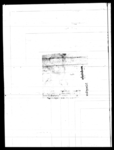A rukkā from King Rājendra re the annual provisions of certain items to Narāja Bāniyā̃ (VS 1880)
ID: DNA_0010_0019
Edited and
translated by Astrid Zotter
Created: 2017-03-06;
Last modified: 2023-02-24
For the metadata of the document, click here
The accompanying edition, translation/synopsis and/or commentary are available under the terms of the Creative Commons Attribution-ShareAlike 4.0 International License
Abstract
This rukkā from the king, who according to the date must have been Rājendra, orders officials involved in the Dasaĩ rituals of Gorkha Palace to provide certain items to Narāja Bāniyā̃ annually.Diplomatic edition
[1r]
1श्रीदुर्गा\[Royal seal]1स्वस्तिश्रीमन्महाराजाधिराजकस्यरुक्का¯ ¯ ¯ ¯ ¯ ¯ ¯ ¯ ¯ ¯ ¯ ¯2आगे•गोर्षादर्वारमादसैंगर्नजान्यापुरोहितभारादारथरघरगैर्हप्रतिनराज
3वानियाँकेपाषि१भेडा१मुड्कट्टा१कोमामुलिवाँधिवक्स्यौंसालवसाल•
4दिन्यागर•ईतिसम्वत्१८८०सालमितिज्येष्टसुदि७रोज१शुभ्म्¯ ¯ ¯ ¯
[1v]
मार्फत्भीमसेनथापामार्फतउदयगिरिTranslation
[1r]
Śrī Durgā
Hail! [This is] an executive order (rukkā) of the supreme king of great kings.1
Āge: To all those priests (purohita), courtiers (bhārādāra), [members of] the six clans (tharaghara) and others who go to perform (garna jānyā) the Dasaĩ [rituals] at Gorkha Palace.
We fixed one thick woollen blanket (pākhi), one sheep (bheḍā), [and] one muḍkaṭṭā2 as usual provision (māmulī) for Narāja Bāniyā̃. Keep providing [it to him] annually.
Sunday, the 7th of the bright fortnight of Jyeṣṭha of the [Vikrama] era year 1880 (1823 CE). Auspiciousness.
[1v]
Through (mārphat) Bhīmasena Thāpā
Through Udaya Giri
Commentary
Though the document is short, clearly scribed and unproblematic in terms of grammar, it raises a number of questions that cannot be answered conclusively in the present state of research. The document establishes a regular allocation of non-monetary provisions to an individual. As the addressees of the document are those in charge of performing Dasaĩ rituals at Gorkha Palace, such provisioning was probably to be financed through the regular budget for the performance of this major state festival and possibly had to do with ritual tasks carried out by Narāja Bāniyā̃. From his fieldwork on Dasaĩ at Gorkha Palace in the 1980s G. Unbescheid (1996: 110) reports that there were "Baniyā Chetris" among the group of servants performing outdoor duties (bahiryā susāre) and that they were specifically expected to provide poles for banners. One of the ten bearers of ceremonial banners who formed part of the escort of the phūlapātī procession was a "Baniyā Chetri" (ibid.: 118). According to N. Chaulagain (2019: 194–196) the ten banners (niśāna) themselves are called by the clan names of the bearers, one of them being a "Bāniyān," and the same set is worshipped in all units of the Nepalese army (cf. DNA_0002_0061 for the sending of prasāda of the kotanisāna).
It is not clear from the document, however, for what service or broader purpose Narāja Bāniyā̃ was provided the items named. Was he one of the bahiryā susāres? Was the system observed in the 20th century already in place at that time? Was the provisioning a non-monetary remuneration for services as ritual specialist and meant for personal use? Or was it a provision of "tools of the trade" with which to carry out ritual tasks (as e.g. the sheep to be sacrificed, the woollen blanket used as a ceremonial garb or as an offering)?


